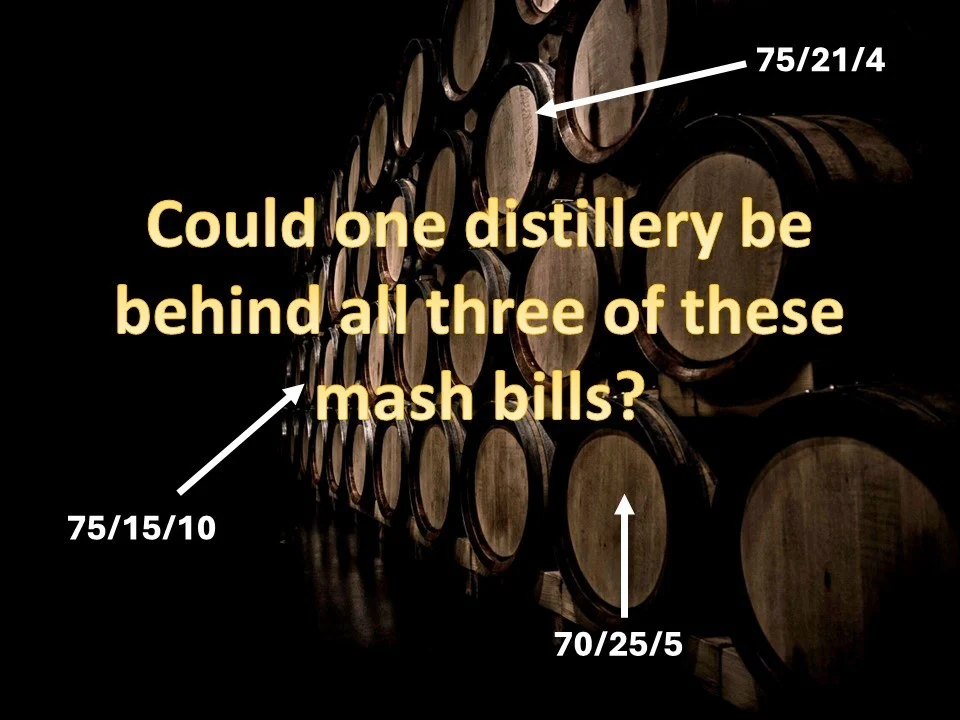| Don't like ads? | No ads |
If you’ve read my reviews, then you know I like to dive in to mash bills and the distilleries that produce them. That’s why I’m kind of annoyed by the fact that distilleries like Bardstown Bourbon Company have been replicating many of the “heritage” distillery’s bourbon recipes. We’re now living in an age where a young 68/20/12 wheated bourbon doesn’t always mean it was made at Heaven Hill and a 60/36/4 ryed bourbon doesn’t always mean it was distilled at MGP in Lawrenceburg, Indiana. Don’t even get me started on 95/5 rye whiskey, there are at least 4 Kentucky distilleries (and one Maryland distillery) that are making their own version. If there was confusion before in the American Whiskey scene, it’s about to get a whole lot more so in the coming years.
People might ask: “who cares where the whiskey was made?” I still think it matters. We all figure out what we like and don’t like and which distilleries make the whiskey that falls into either category. That’s why I try to shame any producer that doesn’t provide information about their mash bills or are cryptic about their origins. Enthusiasts should have a right to know – even if it means having to do a little homework to figure out.
First Sighting of a Kentucky-distilled 75/21/4 mash bill
Back in 2023, I was interested to read about a review about a private label bourbon from social media personality (and former bar owner) Bill Binder. Do I know Bill personally? No. But I’ve seen his social media posts and recognized very quickly about his affinity for Willett. So when he began to source his own bourbon for his own private label line of bottles – and even put “Distilled in Bardstown” on the label – of course I assumed it was from Willett. But then things got weird when he listed the mash bill as 75/21/4. This review dives into the story behind Bill admitting the bourbon was not distilled at Willett.

The bourbon was listed as 9.7 years old which would make it too old to be a random batch of bourbon from Bardstown Bourbon Company (which started distilling in 2016). That also means that the bourbon would have been distilled sometime in 2013. There’s also the possibility that it could have been distilled before 2013 and then vatted/tanked for a period of time. But the most important detail is that there were only two distilleries in operation in Bardstown at that time – Willett and Barton.
So if Bill said it’s not from Willett, that only leaves Barton. Let’s just say I was skeptical about this claim.
Then a second NDP (River Roots) has popped up using the same 75/21/4 mash bill from the same area of Kentucky. In fact, if you reach out to them they will tell you that their barrels are from Barton. But their release puts the timeline of distillation at around 2009 or 2010. This further solidifies the Barton 75/21/4 theory.

Why would Barton make a copycat MGP bourbon?
Most enthusiasts have memorized Barton’s (primary) mash bill – 74% corn, 18% rye and 8% malted barley. This has been documented in everything from Calumet Farm to Sam Houston to Bardstown Bourbon Company Discovery/Fusion series to Jim Rutledge’s Cream of Kentucky label. So why would they be making other kinds?
If we look back at what was going on with Barton from 2010 to 2013, we’d see it butts right up to the purchase of the distillery by Sazerac in 2009. Sazerac seemed to be okay with the distillery continuing to contract-distill bourbon for the foreseeable future. Perhaps creating a new set of mash bills might have been a way to lure new customers in for their business. After all, LDI in Indiana (Barton’s biggest rival in terms of sourced whiskey sales) was facing an uncertain future with their current owners (CL Financial/Angostura) and MGPi would not go on to purchase that distillery for another year.
My guess is that Barton saw the time to strike for new customers was in 2010-2013 and these barrels are a throwback to that time.
Two other random bourbon recipes made by Barton around the same time
I want to point out that two more examples of random mash bills that were distilled around the same time and also came from an “unidentified Kentucky Distillery.” Both of them point back to Barton.
The first is a random 75/15/10 mash bill that is also popping up recently. Be warned that Castle & Key has been making this mash bill for Pinhook, but the barrels are only 4 years old at this point. The barrels I’m talking about were distilled in the same time period as the 75/21/4 bourbon I was just talking about – between 2010 and 2013. I saw a private label of Seelbach’s using the 75/15/10 mash bill show up late last year wearing a 9 year age statement. They’re also releasing a 10 year age statement this year. Here is a Straight Bourbon link that talks about the 75/15/10 mash bill being the kind found in Very Old Barton bourbon and seems to be confirmed by a lot of industry veterans throughout.


The second mash bill is a rather strange 70% corn, 25% rye and 5% malted barley that was also distilled in 2010. By the way, I want to clarify this is not the low-rye Four Roses recipe. That one is “75/20/5.” But this 70/25/5 recipe has been used in some real low-key releases like Barrell Bourbon Batch 003 and 13th Colony’s Southern Bourbon. I have also determined this mash bill is the most likely bourbon base of their Double Oaked bourbon.


Conclusion
What’s the purpose of this article? I wanted to draw attention to some mystery mash bills that many NDPs are playing coy about their origins. I get it, sometimes a Non-Disclosure Agreement says they can’t reveal it. But I don’t like to see customers overpaying for bourbon that they think might be coming from brands that typically fetch a lot of extra money in the secondary market like Buffalo Trace, Wild Turkey or Old Forester. If it’s Barton, the prices (and expectations) should be a little more tempered.
Plus, I think it’s always good to have these things spelled out for the community so that it pulls back the curtain a little bit. Consumers can make more informed decisions and can control their fear of missing out when they know the stakes.
What other mash bills are you curious to find out about? Leave me a comment and let me do the legwork for you!
Featured Products
- Neat Traveler

- View Larger
- Description:The Aged & Ore Neat Traveler is a complete travel kit for spirits. We combined our widely praised Neat Glass with one of our 3oz Flight Bottles and housed them together in a custom EVA travel case. Perfect for a night away with your favorite pour. The tie
- Bottle Flight

- View Larger
- Description:The Aged & Ore Bottle Flight is a premium set of 4 custom silicone wrapped glass bottles designed to transport and share samples of your favorite spirits. The flight bottles come in a custom EVA travel case that fits perfectly in any small bag. An Aged &
- Travel Bundle

- View Larger
- Description:This Bundle combines two of our crowd favorite products, creating the ultimate travel bundle to bring along your favorite spirits and glassware. Bundle Includes: Neat Traveler (Gray) Bottle Flight (Gray) Note: This bundle is only available in gray and col
*Bourbon Culture is reader-supported. When you buy through links on our site, we may earn an affiliate commission.


K Myers
Tuesday 23rd of April 2024
I'm curious about this 78/13/9 Kentucky distilled mashbill that I see popping up that is around 8-10 years old and seems to be distinctly different from the 78.5/13/8.5 "mystery" mashbill that was 15 years old a couple of years ago...
Bardstown uses this mashbill in their Disco series, Augusta uses it in their River Proof series and says it is 0-9 years old and there are two different yeast strains available, and I have seen it used by other NDP's as well...
Mike & Mike
Tuesday 23rd of April 2024
I am almost certain it is from Beam. They got rid of the ".5's" to streamline it and make it seem different. I speculate that both of these recipes are what is found in Knob Creek (contrary to what others believe). The 78.5/13/8.5 mash bill was 15 years old just like the Knob Creek single barrels at the time. Then when they ran out, they dropped the age statements back down to 9 to 10 years old - just like this "new" mystery 79/13/8 mash bill is. I think they're both the same thing just with different aged (which would explain why they taste different)